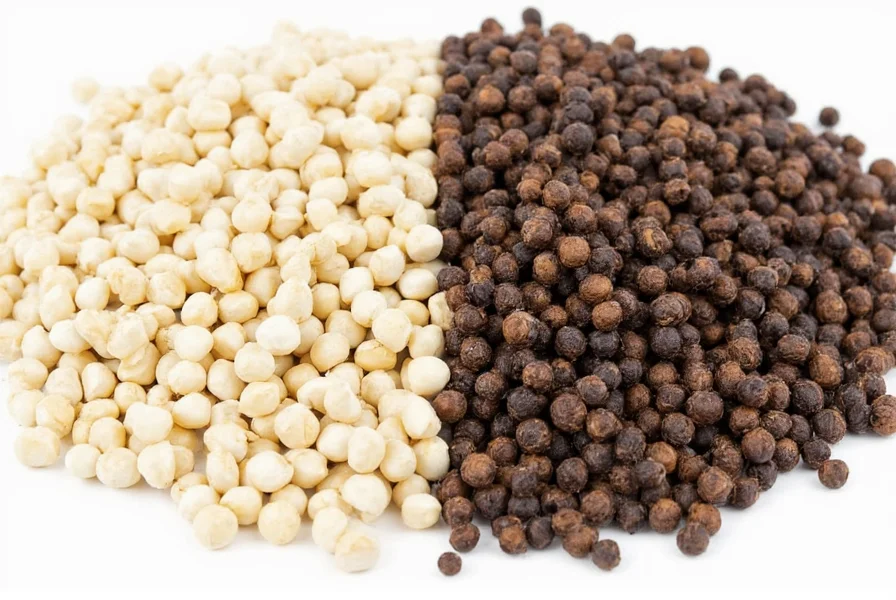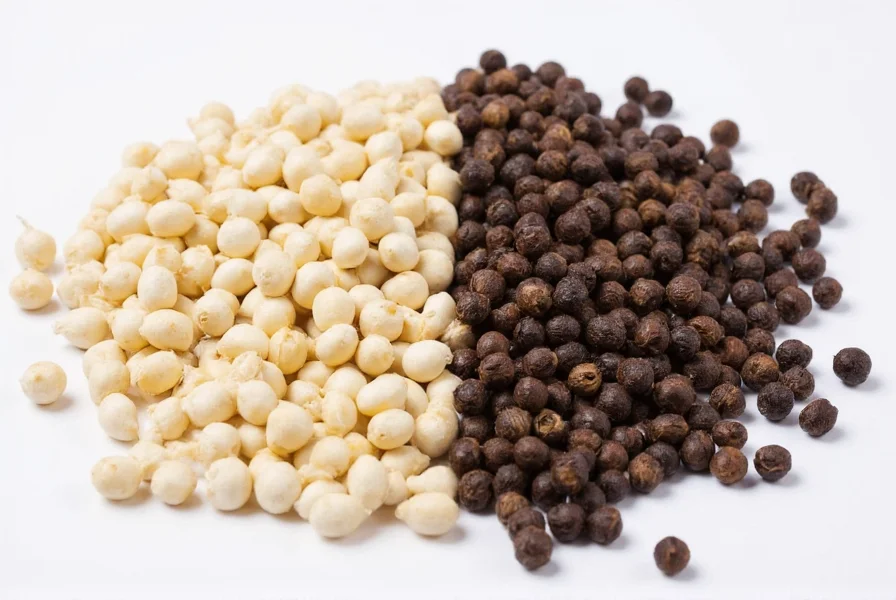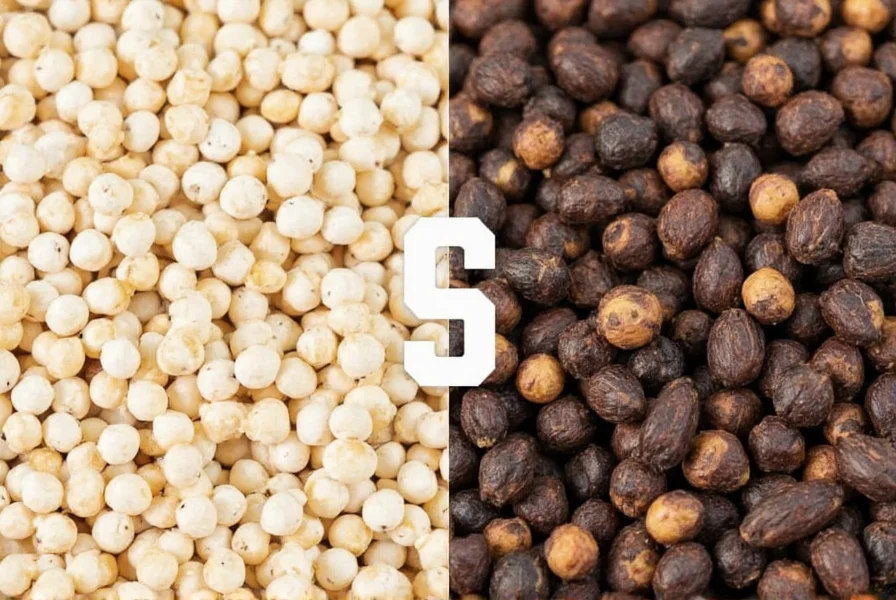Understanding the difference between white pepper and black pepper goes beyond mere appearance—it affects flavor development, dish presentation, and even cultural cooking traditions worldwide. Both originate from the same Piper nigrum plant, yet their processing methods create two distinct spice varieties with unique properties that professional chefs and home cooks should understand to maximize their culinary potential.
Processing Methods: The Core Distinction
The critical difference between white pepper and black pepper begins with how the peppercorns are processed after harvesting. Black pepper results from采摘 unripe green berries, which are then sun-dried until they shrivel and turn black. During this process, the outer layer (pericarp) undergoes enzymatic changes that develop black pepper's characteristic pungent flavor and aroma.
White pepper production involves an additional step: fully ripe red peppercorns are soaked in water for about a week, which ferments and softens the outer layer. This outer layer is then mechanically removed, leaving only the inner seed, which is subsequently dried. This soaking process gives white pepper its distinctive earthy, musty notes that differ significantly from black pepper's sharper profile.
| Characteristic | Black Pepper | White Pepper |
|---|---|---|
| Harvest Time | Unripe green berries | Ripe red berries |
| Processing Method | Sun-dried with outer layer intact | Soaked to remove outer layer, then dried |
| Flavor Profile | Sharp, pungent, complex | Milder, earthy, musty |
| Visual Impact | Visible specks in dishes | Blends seamlessly, no visible specks |
| Common Culinary Uses | Most savory dishes, visible seasoning | Cream sauces, light-colored dishes, certain Asian cuisines |
Flavor Profiles and Chemical Composition
When examining the difference between white pepper and black pepper taste characteristics, the key factor is piperine—the compound responsible for pepper's heat. Black pepper contains approximately 5-9% piperine, while white pepper contains slightly less at 4-7%. However, the flavor difference extends beyond simple heat measurement.
Black pepper delivers a brighter, more complex flavor with citrusy and floral notes alongside its heat. The outer layer contains essential oils that contribute to this complexity. White pepper, lacking this outer layer, presents a more one-dimensional heat with distinctive earthy, sometimes barnyard-like notes from the fermentation process. Many chefs describe white pepper as having a 'warmer' heat that builds more gradually than black pepper's immediate punch.
Culinary Applications: When to Use Each Variety
The difference between white pepper and black pepper in cooking primarily relates to visual presentation and flavor integration. Professional chefs select between these varieties based on specific dish requirements:
Choose black pepper when:
- You want visible specks of seasoning in your dish
- Preparing robust dishes like steaks, grilled meats, or dark sauces
- Seeking a brighter, more complex pepper flavor
- Making spice rubs where visual contrast is desirable
Choose white pepper when:
- Preparing light-colored dishes like béchamel, mashed potatoes, or chicken piccata
- Creating dishes where visual purity matters (white sauces, fish dishes)
- Following traditional recipes from certain Asian cuisines (particularly Chinese and Vietnamese)
- When a more subtle, integrated heat is preferred over pronounced pepper notes

Nutritional and Health Considerations
While both varieties offer similar health benefits as members of the Piperaceae family, subtle differences exist in their nutritional profiles. Black pepper contains higher levels of certain antioxidants from the outer layer that's removed in white pepper processing. Piperine, present in both, enhances nutrient absorption—particularly for turmeric's curcumin—but black pepper typically delivers this benefit more effectively due to slightly higher piperine concentration.
Some studies suggest white pepper may be less irritating to sensitive digestive systems for certain individuals, though research remains limited. Neither variety should be considered a significant source of nutrition, but both contribute beneficial plant compounds to the diet when used as culinary spices rather than supplements.
Storage and Shelf Life Differences
Understanding the difference between white pepper and black pepper extends to proper storage. Both lose potency over time, but white pepper generally has a shorter shelf life due to the removal of the protective outer layer. Whole peppercorns of either variety maintain freshness significantly longer than pre-ground versions.
For optimal flavor retention:
- Store both varieties in airtight containers away from light and heat
- Keep whole peppercorns rather than pre-ground whenever possible
- White pepper typically remains potent for 1-2 years, while black pepper lasts 2-3 years
- Grind pepper immediately before use for maximum flavor impact
Substitution Guidance: Can You Swap Them?
When considering whether you can substitute white pepper for black pepper (or vice versa), the answer depends on your culinary goals. In most savory dishes, they can technically substitute for each other at a 1:1 ratio, but the flavor profile and visual impact will change significantly.
For the difference between white pepper and black pepper substitution:
- When replacing black with white: Use about 25% less white pepper initially, then adjust to taste, as white pepper's heat builds differently
- When replacing white with black: Be aware that black pepper will add visible specks to light-colored dishes
- Some traditional dishes (like certain Chinese recipes) specifically call for white pepper for authentic flavor
- Consider the dish's color requirements when making substitutions

Global Culinary Traditions
The difference between white pepper and black pepper extends to cultural preferences. European cuisines historically favored black pepper for its robust flavor, while certain Asian culinary traditions developed around white pepper's more subtle profile. In French cuisine, white pepper traditionally appears in light-colored sauces and potato dishes, while black pepper features in most other applications.
Understanding these cultural contexts helps explain why certain recipes specify one variety over the other—it's not merely arbitrary but often represents generations of culinary refinement. The growing globalization of food culture has blurred these distinctions somewhat, but professional kitchens still maintain specific protocols for pepper selection based on dish requirements.
Frequently Asked Questions
What's the main difference between white pepper and black pepper?
The primary difference lies in processing: black pepper consists of dried, unripe green peppercorns with the outer layer intact, while white pepper is made by removing the outer layer from ripe peppercorns before drying. This creates distinct flavor profiles—black pepper has a brighter, more complex taste while white pepper offers a milder, earthier flavor.
Can I substitute white pepper for black pepper in recipes?
Yes, but with considerations. You can generally substitute at a 1:1 ratio, but white pepper has a different flavor profile. When replacing black with white, use about 25% less initially as white pepper's heat builds differently. Note that black pepper will add visible specks to light-colored dishes where white pepper is traditionally used.
Why do some recipes specifically call for white pepper?
Recipes specify white pepper primarily for visual reasons in light-colored dishes like béchamel sauce, mashed potatoes, or chicken piccata where black specks would be undesirable. Certain Asian cuisines also traditionally use white pepper for its distinctive earthy flavor profile that's integral to authentic taste in dishes like Chinese hot and sour soup.
Which pepper is hotter, white or black?
Black pepper contains slightly more piperine (5-9% versus 4-7% in white pepper), but the heat perception differs. Black pepper delivers an immediate, sharper heat while white pepper's heat builds more gradually with earthy notes. Many people perceive black pepper as hotter initially, though white pepper can feel more intense over time in certain applications.
Does white pepper have the same health benefits as black pepper?
Both contain piperine, which enhances nutrient absorption, but black pepper generally offers slightly more nutritional benefits due to higher antioxidant content from the outer layer that's removed in white pepper processing. However, both varieties provide similar culinary health benefits when used as spices in normal cooking quantities.











 浙公网安备
33010002000092号
浙公网安备
33010002000092号 浙B2-20120091-4
浙B2-20120091-4